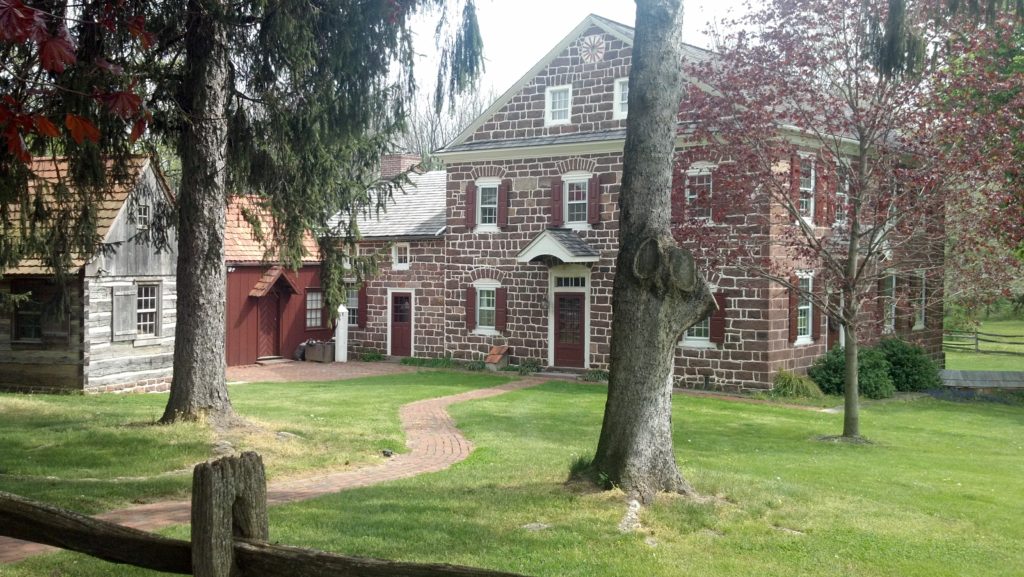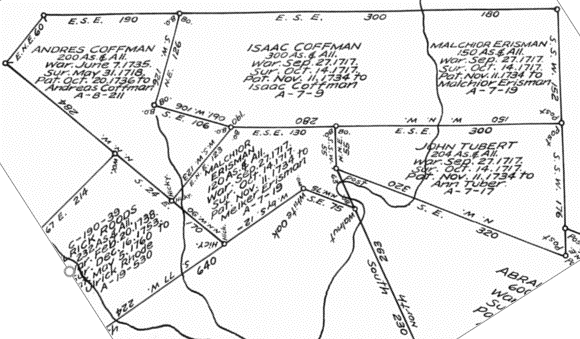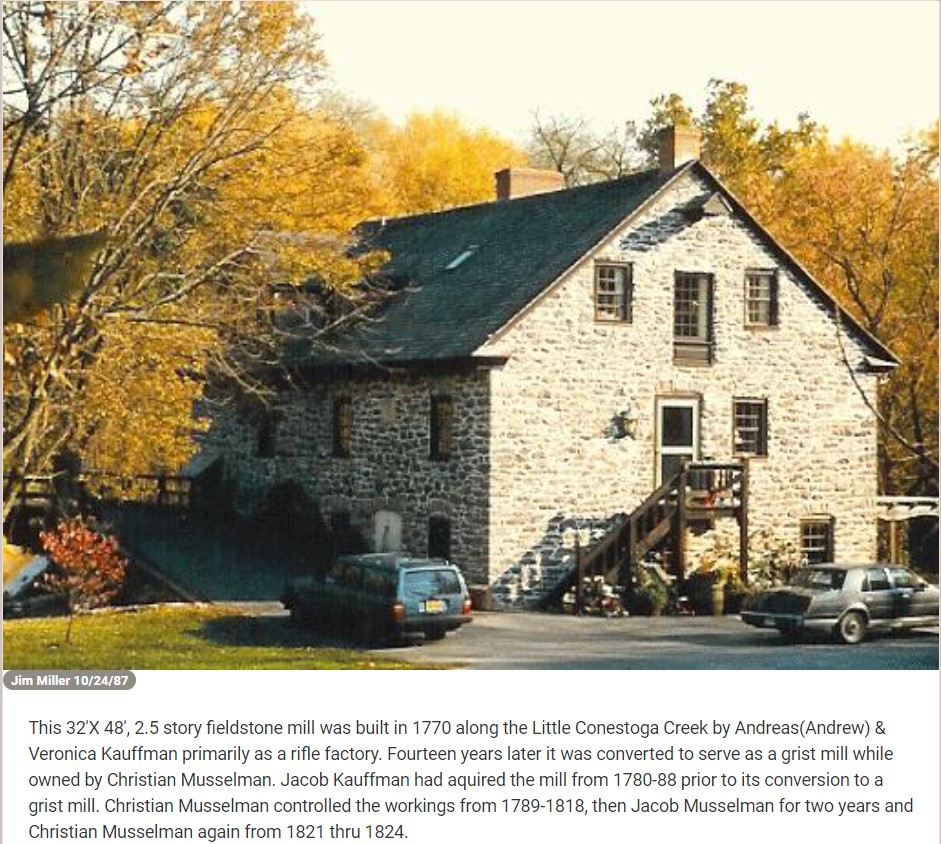In my earlier blog I spoke of the land of Isaac Kauffman, granted under a warrant shown on the map. This farm exists today and is owned by Jere Dickerson. I met Jerry as part of my quest as I visited Lancaster in 2012. The story was quite fascinating. I had gone to Ephrata, some 30 miles north of Lancaster to visit the historical society and subsequently the home of Ludwig Mohler. You recall the story of Elizabeth Mohlerin eloping with John Coover back in early 1800s, something unheard of for Mennonites.

I thought at the time I originally wrote this blog that Ludwig Mohler who lived in this home was the father of Elizabeth Mohler. In fact, her father has the same name but is not this Ludwig. Nor apparently is he the son of Ludwig but of a related Mohler. That is for another day to resolve.
Having successfully located this farm, I set off shortly after noon for a brief trip down to a park slightly west of Lancaster which is described in that story. Well, I saw the remnants of an old barn and beyond I saw an old farm house. Being bold, I went to the door and knocked. This old (given that I was only 60 at the time) gentleman came to the door and opened it, looking skeptically at me. I said my name and that i was traveling thru the area and was looking for the Kauffman Farm. He said, “Well, you found it, come on in.”
The story and tour were amazing. He had purchased the farm some 20 years prior and restored it. He took me throughout, showing me the construction, the expansion, the Indian Door that had slits so you could fire out without exposing yourself to harms way. In the basement he had gravestones with Kauffman’s listed. He explained that when the developers cut up the old farm they wanted to plow under these stones. He rescued them and kept them in the basement. This home was built by Andrew Kauffman in 1756, one of the son’s of Isaac Kauffman. Upon the death of Isaac Kauffman, two sons, Andrew and Christian, were given this farm. Christian sold his half to Andrew and moved to a farm further west. (See the Farm of Isaac Baer Kauffman)
Adjacent to the house was his workshop built on what we believe was the original Isaac Kauffman house. Remember that Isaac came here in 1717. And there is a functioning spring house, where the original spring still exists. I drank of this water, an exciting and emotional event when you think that that is the same water that our ancestors drank of almost 300 years ago.

Andrew Kauffman House 
Andrew Kauffman House

House in the 1980s 
Isaac Kauffman House 
Spring House 
Distant Picture of the House 

Spring
Here is a plot of Isaac Kauffman, Andrew Kauffman, and a few of the neighboring tracts taken in 1717 and 1718. It is situated on Route 30 (Lincoln Highway) a little west of Lancaster, PA.
The Deed reads:
At a black oak on the corner of the Hams Brubaker tract, began the Andrew and Isaac Kauffman tracts, the Andrew Kauffman homestead beginning at the corner marked by a black oak, thence W.N.W. 190 perches (16.5 feet) along Michael Miller Bare’s kmd W’S.W.60 p. to a post at John Witmer tract; thence along Witmer tract and vacant land SSE 284 p. to a hickory marking corner of Melchicr Erisman tract, N .N .W. 123 p. and along same to corner black calc of Isaac Kauffnan; thence NNW, 106 p. along Isaac Kauffman tract to a black oak; thence N.E. 126 p. along Isaac Kauffman tract to beginning point, containing 200 acres. Isaac Kauffman tract begins at black-oak corner E.S.E. along Hans Brubaker 300 p. thence S. along the various courses of the Little Conestoga Creek, 160 p. on Hans Tnhcr line; thence W.N.W. along lines of Tuber and Erisman 300 p. to corner of black oak of Erisman and Andrew Kauffman’s tracts; thence along Andrew Kauffman’s tract two lines (see above) to beginning of black oak: area 300 acres. Hans Brubaker tract beginning at bIack—oak corner of Kauffmans and Michael Miller, E.S.E. 480 p. to a hickory at Erisman corner; thence N.N.E. 354 p., then NNW 480 p.; thence S.5.W. 354 p. to black oak beginning point; area 1000 acres.

You get the idea. Hopefully those Black Oak and Hickory trees are still there.
A note on the Andrew Kauffman history says that the owner of that property destroyed the cemetery where Andrew Kauffman and his son lie. Hopefully this owner did not destroy the gravesite of Isaac on the adjoining property. (I later found out that Isaac Kauffman was buried at the cemetery of a local Mennonite meeting house. It in fact was destroyed many years ago when civilization encroached on this area.
The Barn shown in the photos was destroyed by fire back in the 1960s. It was full of hay and some young boys were playing with matches.
Stories of the history of Manor Township has been directed in the past to the 16,000 acres originally surveyed as Penn’s Manor. Between the northern border of the Manor (about the line of Charlestown Road) and the Lancaster Columbia Turnpike lies an area once part of Chester County, then Hempfield Township, and which in 1759 became part of today’s Manor Township. In this northeastern corner, bordered by the Little Conestoga and the Columbia Pike lie Manor Township’s oldest settlements. Here Isaac Kauffman, Melchior Erisman, and Hans Tubert took 675 acres of land in 1717. The tract was divided three ways, with the Kauffman tract to the west of the Little Conestoga and Tubert’s and Erisman’s land extending eastward into what is now Lancaster Township. Isaac Kauffman may have been the son of Tauferleher Isaac Kauffman, who lived at Homberg, Parish of Steffisburg near Thun, Switzerland. His warrant for the land reads as follows:
By the Commissioners of Property
At the request of Hans Tuber, Isaac Cofman and Melker Erisman, all of the Township of Strausburgh in this province, that we grant them to take up in or near said Township the quantity of Six Hundred Seventy five Acres of land for which they agree to pay to the Proprietors use sixty seven pounds ten shillings money of the said Province for the whole, and the yearly quit rent of one shilling sterling for. every hundred acres and in proportion for the seventy five acres. These are to authorize and require thee to survey or cause to be surveyed unto said Hans Tuber, Isaac Cofman, and Melker Erisman in or near the place aforesaid according to the method of the Townships appointed, the said quantity of six hundred seventy five Acres that bath not been already surveyed nor appropriated nor seated by the Indians and make returns thereof into the Secretary’s Office of which survey in case they, the said Hans Tuber, Isaac Cofman and Melker Erisman fulfil the above agreement within three months after date hereof shall be valid. Otherwise, the same is void as if it had never been made nor this warrant ever granted.
Given under our hands and seal of the Province at Phila. ye 27 day of September, Anno Domini 1717 to Jacob Taylor, Surveyor General.
Richard Hill Isaac Morris James Logan
This is probably the oldest warrant for land in Manor Township, the previous owners being the English Proprietors of Pa. and their agents. Obviously, Kauffman, Tubert, Erisman and their neighbors, Andrew Kauffman, Hans Pupather (Brubaker), Henry Bare, John Witmore, Abraham Herr and others selected this location because of its gentle rolling terrain and strong, clear springs flowing into the Little Conestoga and its branches. It is probable that none of the ‘original dwellings from this early settlement remain today, as most were probably log cabins built over or near the springs. However, many houses, mills, barns, and other outbuildings constructed by later generations of these pioneers may still be found standing on the same locations.
Isaac Kauffman died in 1738, his wife Elizabeth in 1751. Their children were Jacob, Christian, Audey, Elizabeth, Anna, Isaac, and Andrew. Elizabeth and Anna married neighbors John and Jacob Neff and Christian and Andrew married Barbara and Fraena (Feronica, Veronica) Baer, daughters of neighbor Henry Baer. (see map) –
Sons Andrew and Christian inherited the homestead and Christian sold his share to his brother and moved to a larger tract east of Washington Boro. Andrew and his wife Fraena built a house near the original homestead, which is still standing. It has seen several architectural changes, but the date stone with A.K. F.K. 1767, may still be seen high in the wall. Three years later, when building his mill on the Little Conestoga on the southeastern corner of the property, Andrew signed the stone “ERBAUET Von ANDREAS KAUFFMANN and VERONICA KAUFFMAN anno 1770.”
There is some evidence that this beautiful stone mill, built six years before the Revolution, may have been used at times as a rifle factory. It is fact that Andrew Kauffman had to pay water rights to his neighbor Daniel Erisman, across the stream. This was because part of Erisman’s property was flooded by the mill pond, and Kauffman was not to allow the water to rise above an “M” marked into a cornerstone on the southeast side of the mill. This corner of the property and the mill were later sold by Andrew Kauffman to his son-in-law, Henry Eberle. It has since passed through many hands and was operated in later years by the Stoneroad family and became known as Stoneroad’s Mill.

Most of the older residents of the area, however, refer to it as Kauffman’s Mill and now that its wheel and gears are silent it is only proper that this should be its permanent name. The 1815 tax records show several milling operations in the Kauffman family. Probably the family ran the stone mill at Maple Grove, as Andrew Kauffman’s daughter was married to John Stoner. This mill was built by Johannes Stoner (John Stoner) in 1767 and has fallen into bad repair. The Stoner family also built a large stone dwelling just west of the mill which was used as an inn for many generations. This building, once known as one of the finest stone houses in the county, was recently demolished to make way for a modern restaurant.
After Andrew Kauffman’s death in 1785, his son Andrew sold part of the original property to his brother-in-law, Christian Stoner, who in turn sold 180 1/2 acres to William Gamber in 1801. The remainder of the land was farmed by Andrew Kauffman’s grandson Henry and wife Catherine, who are both buried on the property.
The northern half of the property has been owned by several generations of the Gamber family. This family probably rebuilt Andrew Kauffman’s home, and added many other buildings on the property. One 21/2 story brick house, built over one of the springs, is presently being restored and is nearing completion on Gamber Lane. Nearby can be seen the Kauffman house, a stone building, listed in the tax records as a still house from 1801 to 1826, several old barns, and a spring house rumored to be the site of an early log cabin. The Lemon Tree Restaurant on the Columbia Pike and several other buildings, including later farm houses, are still in use on the property.
Some of the area has become highly commercialized and developed, but a short tour of the northeast corner of the. township (see map) will quickly reveal its history. Stoner’s Mill at Maple Grove, Kauffman’s Mill, and two beautiful brick houses nearby, another mill downstream where the Millersville Road crosses the Little Conestoga, and two fine stone houses nearby built by members of the Herr family may all be seen today.
Perhaps your interest in the past will be stirred by picturing the Kauffman brothers, travelling on horseback or by wagon about a mile and a half through woodland to court Fraena and Barbara Baer and then comparing the same route today (see map). Maybe the ages of the people resting in the family cemetery will reflect, a once peaceful and healthful existence. William Gamber, 92, wife Anna, 82, Rudolph Gamber, 75, wife Mary, 71, and Catherine Kauffman, wife of Henry, 85, all passed on more than a century ago-. The next time you visit your favorite quick stop eating place along today’s commercial Columbia Pike, remember that just two blocks south you can catch a glimpse of the past. Here Isaac Kauffman’s springs, still clear and strong, provide water for the present owners and join to form a stream that flows almost timeless through a meadow toward the Little Conestoga.
The stones in the cellar were of Henry H Kauffman and his wife, Catherine
- Henry (1783-1851)
- Catherine (1790-1873)
Jere had rescued them from an adjacent property that was being developed. The construction crew had tossed them aside.
Jere also showed me on the map the location of the Meeting Place where Isaac Kauffman was buried. Here are several maps and other information from a not so recent publication that I located. As you can see, the local development of the late 1990s resulted in the destruction of many cemeteries around the area. Subsequently, the State of Pennsylvania has banned this practice.



















